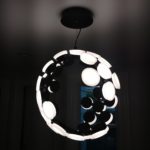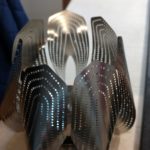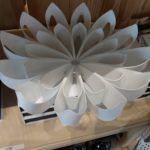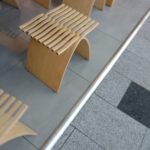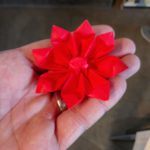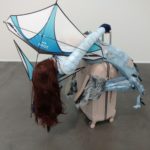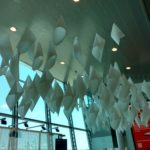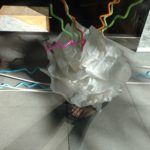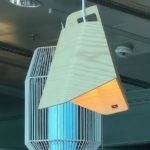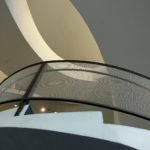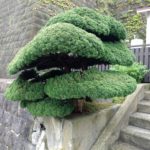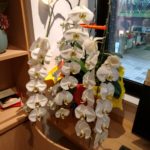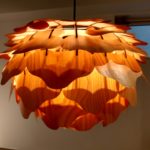Design Concepts
- Staked Design Methods/Non-traditional Materials – Armatures created by staking together non-traditional sculpture materials. Example materials include green sticks or lumber. Could also include cable/rope.
- Rigid vs. Flexible. How does the skin interact with the armature?
- Import physical designs into computer aided design software to produce textile coverings. (Could these also be structural elements?)
Challenges (Running Tally)
- Can students digitize models? Unclear.
- Test with student.
- Would software support help?
- Talk with Luke. How long was his course?
- Can students cut patterns with laser cutter? Yes.
- Yes, we managed this last semester.
- Create better laser sign-up expectations.
- Can students sew pieces with sewing machine?
- Probably? But how much training.
- Look online for sewing machine training.
- Can I make a self-supporting 3-D form from fabric and sticks? Yes.
- Tetrahedron from sticks and muslin worked great.
- Can I make curved faces and edges? Yes.
- Concave faces achievable in the hyperbolic tetrahedron model and the Ikea Chair Tent.
- Convex edges achieved with Irrigation pipe. Pipe made a great flexible edge support for the dome tent.
- Are we interested in non-solid body wrapping uses of the fabric (e.g. Space Ship)?
- Speak with Joe.
Design Iterations
I tried a variety of materials: bamboo sticks and muslin, Bamboo/Boards/Muslin. Next I want to try a more flexible material.
Process
I modeled the designs using Autodesk Fusion 360, unwrapped the fabric faces of 3-D forms using Autodesk Meshmixer, and cut the muslin using our Makerspace Laser cutter.
Material: Bamboo Sticks and Muslin
Triangular Pyramid (Regular Tetrahedron)
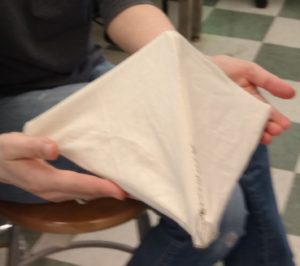 Status: Made and done.
Status: Made and done.
+ Stood up on it’s own
+ Corners formed pockets for the sticks
– Getting stacks into place was finicky
– Only flat faces are possible with sticks supporting each edge
Hyperbolic Pyramid
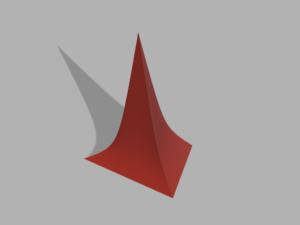
Status: Made but didn’t close the bottom face.
+ Peak formed pocket for the sticks
+ obtained curved edges
– Getting stacks into place was finicky
– Only have 1-D curve on faces
Three-way Hyperbolic Pyramid Intersection
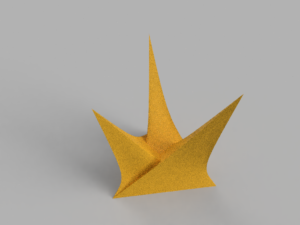
Status: cut out pattern but need to make the base plate.
+ Interesting form from several angles without many panels
– Couldn’t figure out how to make the sticks align without a base plate
Elliptical Vase
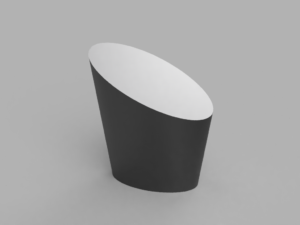
Status: Postponed until bendable materials obtained, could also be implemented with two hardboard sheets.
+ Simple implementation of a 1-dimensional curve that is easily unwrapped into a sheet of fabric.
– elliptical edge at the top face and round edge on bottom face not easily supported with bamboo sticks
Overall “Stick and Muslin” Impressions
+ Materials cheap (muslin was $1.20 per 50″ yd., bamboo sticks at garden center $0.20)
– Fabric to stick connections are finicky and affect surface shape
– Difficult to create convex textile faces that aren’t fully supported by armature
Bamboo Sticks + Hardboard + Muslin
“About to Break” Wave
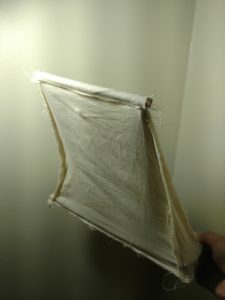
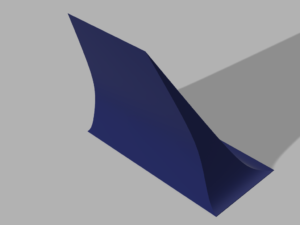
Initially tried to design this as a “stick-only” design but the connections between the sticks and the fabric were too frail. Worked well once I added cardboard.
+ Stood up really well with plate
– Wish I could create a more curling form (can’t make a convex shape).
– Wish I could make the leading edge more interesting.
Dome Section
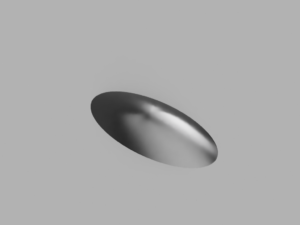
Status: Unwrapped in software but not laser cut. Bamboo sticks don’t bend well enough. I would like to try the design again with very stretchy sticks. Would like to cut to allay concerns about two-dimensional curvature in the round face.
http://a360.co/2s2hSAd
Tent
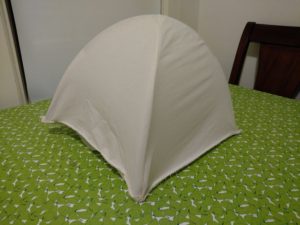
 1-inch irrigation tubing forms the “tent poles” supporting the top faces.
1-inch irrigation tubing forms the “tent poles” supporting the top faces.
“Space Ship?”
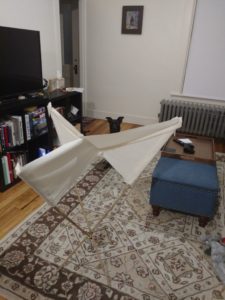
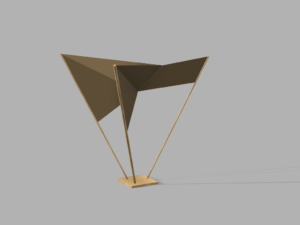
Status: Sewn but not totally finished. Had issues with the poles not fitting into place. I mis-cut one of the panels, probably caused the issue. I resolve this by wiring the poles together instead of using the board. I want to try nicely finished seams on this one. (Will update when I finish the seams).
+ This thing is pretty big! Each pole is 46 inches long.
+ Uses a lot less fabric than a wrapped form but still has mass.
– Not much to look at. Definitely needs some color!
Potbelly Double Diamond
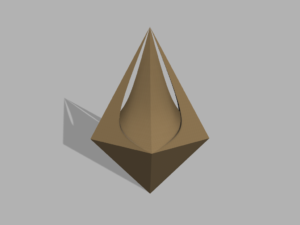
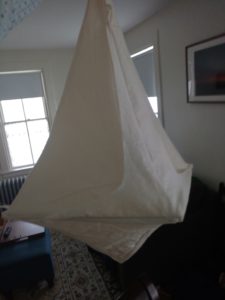
Status: Sewn but not totally finished at the top two seams.
– Wrapped form used a lot of fabric.
– Not much to look at. Definitely needs some color!
Airplane
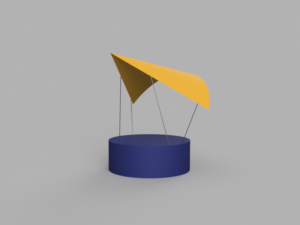 INSERT PHOTO
INSERT PHOTO
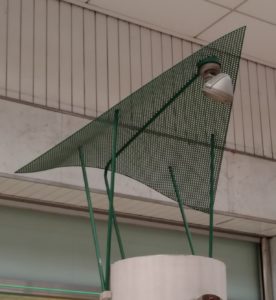
CUT?
Status:
+
–
Folded Altar
 INSERT PHOTO
INSERT PHOTO
CUT?
Status:
+
–
Hanging Flower
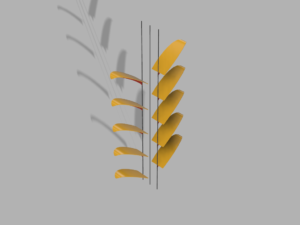
INSERT PHOTO
 CUT?
CUT?
Status:
+
–
Hexagon Medalion
 INSERT PHOTO
INSERT PHOTO
CUT?
Status:
+
–
Layered Tree
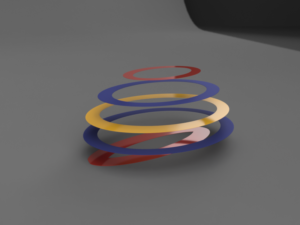
INSERT PHOTO
 CUT?
CUT?
Status:
+
–
Tetrahedron
 INSERT PHOTO
INSERT PHOTO
CUT?
Status:
+
–
Fountain Stand
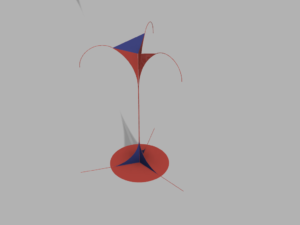 INSERT PHOTO
INSERT PHOTO
CUT?
Status:
+
–
Material: Found Objects as Armature
With the found objects I wanted to try digitally modeling found objects and then using lessons learned from the stick-based armatures to re-shape the objects.
Ikea “Grund” Folding Chair
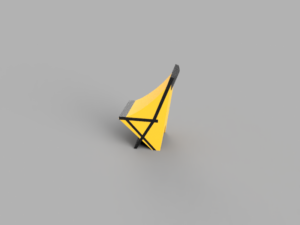
Status: Cut out the fabric and partially sewn but made a scaling error (it doesn’t fit).
Lessons learned: Double check measurement on object in Illustrator.
+ Interesting design challenge to hide the form
+ Standardized armature that is easily obtainable
– Creating the chair model is harder than a more simple block-and-pole construction.
Re-draw as a table: Design Name/Photo, Material, Status
Lessons Learned:
- Double-check scaling in Illustrator right before Lasering.
Next Steps:
- Challenges:
- What would a small scale starter project look like.
- Are materials costs reasonable?
- Evolve process to make strong
- Rather than creating wrapped forms, try creating flat forms.
- Gravity influenced forms.
- More “bendy” stick materials
- Shrink Wrap might be a fun alternative to fabric.
- Work larger.
Inspiration Gallery:
Bibliography:

